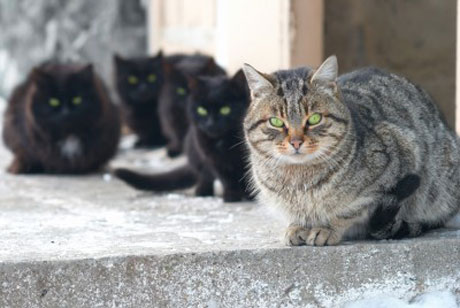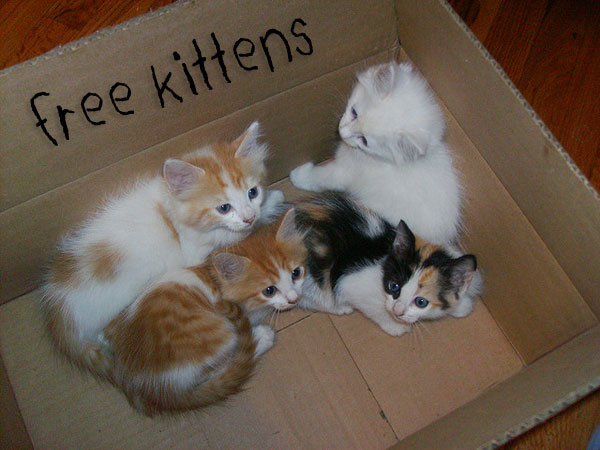A Roundtable Discussion on Cats for Spay/Neuter Awareness Month
Kittens. In my day, it was not uncommon to see a kid holding a box with a litter of them that read, “Free to a good home.” It was also not uncommon to see free kittens advertised in the classified section of the newspaper. And if you were going to the mall, a side trip to the pet store to visit with the kittens (and puppies) was always in order even if you had no plans to buy one. None of these scenarios came with baggage attached as to whether or not there was a larger implication at hand with all of these animals at the ready.
My childhood cat was personally responsible for two litters and back then I had zero knowledge of subjects such as spay/neuter, cat overpopulation, feral cats, euthanization, and TNR. I got to witness her giving birth firsthand and I suppose I was given some sort of magical explanation about her pregnancies by my Mom, because I had absolutely no idea how sex worked back then. We always found homes for her kittens and I would imagine my knowledge and experiences echoed that of just about anyone else born in the early 60’s.

Years ago I had no idea that a kitten could conceive at such a young age. I also did not know they could be spayed or neutered so young either.
As I got older, a general awareness about shelter cats evolved with me, primarily through the maudlin ad campaigns from the American Society for the Prevention of Cruelty to Animals (ASPCA) that left me feeling sad (so much so that I usually changed the channel) and overwhelmed rather than educated. Bob Barker of the Price is Right game show was the one who informed me I should “have my pet spayed or neutered” but neither Bob or the ASPCA caused me to connect the dots in any solid fashion that there would be less cats in the shelters if people spayed or neutered their pets.
I had absolutely no clue of the staggering numbers (millions) of homeless cats living on the streets and in shelters or the horrific numbers of them being euthanized to control the population. My knowledge of spay/neuter came from my vet(s) and it was almost exclusively related to behavioral issues – my female cats were spayed to stop the endless noises associated with a heat cycle and the males were neutered to deter spraying on the furniture and territorial fighting with my other cats.
With February being National Spay/Neuter Awareness Month it got me to thinking about it all – just when did the cat population in shelters and the streets reach epidemic numbers? Was there a watershed moment in time where we can pinpoint when it started or did cat overpopulation exist to the extent it does now when I was younger and we just didn’t know or talk about it? Or is it something that has been gradually happening for years, escalating to the outlandish proportions of today?
We might never know the answer to this because the data available on the estimates of cats brought to shelters and subsequently euthanized is so convoluted and unreliable. I became involved in cat advocacy issues in 2011 and since then, I have read the same numbers every year from the Humane Society of the United States – that 6 to 8 million animals are taken to shelters, 3 to 4 million of them are euthanized, and of those euthanized, 2.7 million of them perfectly healthy and adoptable.

Millions of cats on the streets and in shelters… just when did it all begin and how do we make it stop?
Shouldn’t these numbers change each year and why are they collectively lumped as one category – animals. Wouldn’t it be more beneficial to know the breakdown between cats, dogs, exotic pets, and so on? Yet none of this is possible because there is no central data reporting system in the U.S. to organize these statistics to estimate the numbers of animals entering shelters/rescues or the numbers euthanized on an annual basis.
So what does it all mean – all these numbers, concepts, and questions? I have loved cats my whole life and as I have gotten older, I have certainly become more knowledgeable about them. But before my entrenchment in cat advocacy issues, my knowledge was cursory and all of this begs a larger question – if I had not become an author, blogger, and cat advocate – a role that immerses me daily with like-minded peers, colleagues, experts, and friends, just what would I know today?
Would I have learned enough about spay/neuter, TNR, feral cats, and cat overpopulation from my everyday mainstream life to understand that spay/neuter is not only a safe and humane means of reducing cat overpopulation, but a procedure that helps to ensure a cat lives a longer, happier, and healthier life? Sadly, I have to say that the answer is probably not. I have become self-educated because I now purposely seek out television shows, social venues, and other avenues that are specifically cat related. But think about it – pretend you are not part of cat blogs, rescues, and other cat related venues. Look and listen to the regular world around you. Is the message being relayed in the mainstream world on TV, radio, etc. in such a manner that most people understand why spay/neuter is so important to controlling cat overpopulation?

Teaching responsibility at an early age is one of the most important avenues toward making a difference in reducing cat overpopulation in our world – it just needs to be done at age appropriate stages.
I know when I watch television, the majority of the shows I watch that do happen to mention cats, do it in a derogatory manner for laughs – almost exclusively in a scenario that pits single women and cats together in a stereotypical relationship synonymous with lonely and crazy – certainly nothing educational about that. I think in a general sense most people are aware there are animals in shelters that need a good home. I also think that most people when adopting a pet, would go to a shelter rather than buying a purebred. But do most people truly understand how or why all these animals ended up in the shelter in the first place and how important spay/neuter is for reducing those numbers? I don’t think they do.
And what about our youth who are bombarded all day long with snippets of information from Facebook, Twitter, Instagram, and YouTube? Do they get the message in their everyday lives, enough to make a difference, and if they do, is the information accurate? Do you think lesson plans on spay/neuter and pet responsibility should be mandatory subject matter at some point in grade, middle, or high school to talk about it?

One of the best educational tools to informing the public about the need for spay/neuter is to get the facts straight.
All of these questions got me to wondering about all of you. Do you remember how, when, why or where you learned about the importance of spay/neuter? What do you think is the most effective way to inform people who don’t know that spay/neuter can help control cat overpopulation? And what about kids – what age do you think it is appropriate to start talking to them about spay/neuter? Let’s take Spay/Neuter Awareness Month to heart and get a discussion going so we can try to figure this out so we can help make a difference for our beloved feline friends.
For further information on spay/neuter, cat overpopulation, and additional cat facts, please reference these detailed articles:
Zee & Zoey’s Spay/Neuter Series – The Facts of Life: The 101’s of Kittens and Conception
Zee & Zoey’s Spay/Neuter Series – Cat Overpopulation and the Moral Ethics of Time
Zee & Zoey’s Spay/Neuter Series – Making Sense of Cat Overpopulation When the Numbers Don’t Add Up

























Great post! I remember the days of total irresponsibility in terms of spaying & neutering pets, especially cats. We always had a cat around the house and my parents never thought about spaying them! The awareness just wasn’t there. I think I was probably in my early twenties when I realized that one should always spay & neuter a pet cat or dog, however it wasn’t until I stated volunteering at an animal shelter 7 years ago that I fully grasped the enormity of pet over population. It amazes me that there are still so many people who refuse to spay/neuter! More education is needed through our schools as well as community outreach through animals shelters and other organizations. I think kids can be taught at a very young age that pets should be “fixed”. The details of how an animal becomes pregnant need not be delved into in vivid detail in order to get the point across that it’s critical to spay/neuter.
Love & Biscuits,
Dogs Luv Us and We Luv Them
This is such an important concept: I volunteer for one our local spay and neuter clinics and we really need to get this situation under control in most cities across the country.